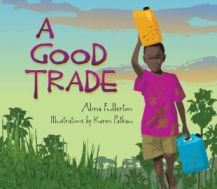A Good Trade
 A Good Trade
A Good Trade
Fiction, Elementary, Picture Book
Pajama Press
2013
Unpaged
ISBN 978 0 9869495 9 3

" In a small Ugandan village, Kato wakes early to start the long barefoot trek beyond his village and along fields dotted with cattle and guarded by soldiers. As it is every day, his destination is the village well, where he will pump a day's supply of water into two jerry cans before trudging home again. But this is no ordinary day. The aid worker's truck arrives at the village square, and in the back is a gift so special, the little boy rushes home to look for something to repay the aid worker." Publisher's Note
This story presents a day in the life of little Kato who lives somewhere in Uganda. He rises at dawn in his “hut” then walks alone to collect a daily ration of water from the village pump. He passes a pasture of cattle guarded by soldiers, meets other children at the borehole, washes his dusty feet, then struggles up a hill with his heavy load. He pauses at the village square, spies an aid worker’s truck and picks a white poppy in the fields. He is first in line to exchange his poppy for the new shoes the aid worker gives all the children.
The book paints a story of a simple day’s activities but juxtaposes this against subliminal messages of war and poverty. What will children make of this subtle story? Why are soldiers guarding the cattle? Why don’t the children have shoes? Why are aid workers there? These questions overshadow the title A Good Trade. What is the good trade? Is it the white poppy for shoes or is it peace from years of war — which war? Both the author and illustrator hint at the political and social context of this story but most North American students would not understand the subliminal message being conveyed. Ultimately the story may simply reinforce the stereotype of barefoot African children in need.
Published in Africa Access Review (April 17, 2014)
Copyright 2014 Africa Access
Reviewed by: Patricia Kuntz, Independent Scholar and Anne Waliaula, University of Wisconsin
